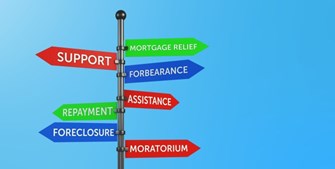Despite a strong economic recovery and an increase in hiring throughout 2021, millions of Americans are still at risk of losing their home after the foreclosure moratorium ended on July 31, 2021. According to the Week 36 Household Pulse Survey by the U.S. Census Bureau, more than 7 million households are behind on their mortgage payments. Fortunately, there are options available to homeowners impacted by the COVID-19 pandemic that could help them avoid losing their home to foreclosure.
The CARES Act created two protections for homeowners struggling during the COVID-19 pandemic: a forbearance period for mortgage payments and a moratorium on foreclosures. Both of these protections applied only to federally backed mortgages (those backed by Fannie Mae, Freddie Mac, HUD/FHA, USDA or VA), but many private loan servicers created their own forbearance programs during this time. Let’s go over where each of these homeowner protections stand today.
Forbearance
The CARES Act made forbearance plans available to homeowners with a federally backed mortgage who experience financial hardship due, directly or indirectly, to the COVID-19 emergency. According to the U.S. Government Accountability Office, mortgage forbearance has been widely used. Use of forbearance peaked in May 2020, when 3.4 million mortgages, about 7 percent of all single-family housing loans, were in forbearance.
Initial forbearance plans typically last three-to-six months and could be extended up to 12 months, with some eligible up to 18 months, depending on when the initial forbearance period started. According to the Consumer Financial Protection Bureau (CFPB):
“If your mortgage is backed by Fannie Mae or Freddie Mac: You may request up to two additional three-month extensions, for a maximum of 18 months of total forbearance. But to be eligible, you must have been in an active forbearance plan as February 28, 2021.
If your mortgage is backed by HUD/FHA , USDA, or VA: You may request up to two additional three-month extensions, for a maximum of 18 months of total forbearance. But to qualify, you must have requested an initial forbearance plan on or before June 30, 2020. Not all borrowers will qualify for the maximum.”
What happens when forbearance ends?
When a homeowner’s forbearance period ends, they must work with their loan servicer to enter a repayment plan to make up missed mortgage payments. Repayment options that may be available to you include:
A repayment plan. This option increases your mortgage payment each month and adds a portion of the total missed payment amount to your monthly payment.
Deferral or partial claim. These options allow you to return to paying your regular mortgage payment amount. The deferral claim option will move your missed payments to the end of your loan, and a partial claim will create a subordinate lien that is repayable when you refinance, sell or terminate your mortgage.
Modification. This option allows you to reduce your regular mortgage payment to an affordable amount and add your missed payments to your total amount owed. While this does reduce your monthly payments, it may extend how long it takes to pay off your loan, and potentially increase the total interest paid on your mortgage loan.
Reinstatement (lump sum). If you have the funds to make a lump sum payment of your missed mortgage payments, this may be the option for you. Most loan servicers cannot require a lump sum payment. If this is the only repayment plan explained to you, ask if there are other options.
Not all repayment options are available to borrowers. You can learn more on the CFPB website, but you should reach out to your loan servicer to learn which options are available to you.
Foreclosure
If homeowners do not work with their loan servicer on a repayment plan, they may be at risk of default or foreclosure actions. While the federal foreclosure moratorium ended on July 31, 2021, some states and local governments have temporarily suspended foreclosures beyond this time. You can check your state’s government website for additional details.
Additional protections also have been implemented since the federal foreclosure moratorium expired. Fannie Mae, Freddie Mac, HUD/FHA, USDA and the VA all extended eviction moratoriums through September 30, 2021.
Lastly, the 2021 Mortgage Servicing Final Rule went into effect on August 31, 2021. This places additional rules on foreclosure for all mortgage servicers, not just those who are federally backed. Under this rule, servicers generally cannot start the foreclosure process until January 1, 2022. Due to this rule, if your servicer contacts you near the end of your forbearance, they generally must tell you:
- The date your forbearance program will end
- Your options for repaying your missed payments and avoiding foreclosure
- Information on how to contact free housing counseling services
Exceptions to the 2021 Mortgage Servicing Final Rule apply, so it is best to stay in contact with your servicer. If your loan servicer is unable to contact you for three consecutive months, they may be able to start the foreclosure process despite this rule.
Additional Resources
For more information about mortgage relief options and current rules on forbearance and foreclosure, visit the CFPB’s Help for Homeowner’s webpage.




